💬 Easy/Newbie PCB for MySensors
-
@N00phi for the capacitors: http://www.distrelec.ch/search?q=electrolytic+capacitor&filter_Rated+voltage~~VDC=50&filter_Diameter+housing~~mm=4&filter_Diameter+housing~~mm=5 (choose the axial types which is the one with two legs).
As for the voltage regulator I use LE33ACZ 5V-3.3V which i cant find on that site.
-
@sundberg84 said in
 Easy/Newbie PCB for MySensors:
Easy/Newbie PCB for MySensors:choose the axial types which is the one with two legs
Just for clarification, there is axial lead and radial lead components. The axial leads have both wires coming out of one side (as @sundberg84 mentions it looks like two legs). Radial leads have one wire coming out each side. I almost never use radial lead capacitors.
-
@sundberg84 Thank you! One more question.. on the photo, there is a flat broun capacitor, what are the specifications for that one? Is it 0,1uF? But thats not an aluminium electrolytic capacitor, is it?
Oh, and the voltage regulator is available on aliexpress, found that one.
-
@N00phi said in
 Easy/Newbie PCB for MySensors:
Easy/Newbie PCB for MySensors:@sundberg84 Thank you! One more question.. on the photo, there is a flat broun capacitor, what are the specifications for that one? Is it 0,1uF? But thats not an aluminium electrolytic capacitor, is it?
Oh, and the voltage regulator is available on aliexpress, found that one.Yes it's the 0.1uF capacitor. It's a ceramic disc capacitor, but you won't have to search for the type of capacitor on aliexpress, low value capacitors are most of the time (always ?) ceramic disks if they are not of SMD type.
-
I would like to use this PCB with a 3.3V I2C sensor (data line and power must be <3.6V) and AC power. Is there a recommended way to accomplish this?
-
@cmrockwell - Sorry, Im not following...
AC Power? You need some AC-DC converter then and this is not the intend of the PCB, sorry.
-
@sundberg84
Sorry, I wasn't clear. I just meant running from a DC power supply, not batteries. It seems that the intended use is to have 5V Vcc when running from a power supply, but I would like a 3.3V Vcc. Thanks for your help. I have 10 of these PCBs in hand.
-
@cmrockwell You can use a 3.3V / 8MHz pro-mini board and power everything with 3.3V.
-
@cmrockwell - yes, the pcb is designed like @cmrockwell said. You can use either 3.3v or below (batteries) or a 5v regulated voltage. If you choose the 3.3v/bat version you need a 3.3v pro mini.
-
@sundberg84
OK, I figured out how to do what I wanted. I am planning to connect a regulated power supply that provides ~3.3VDC. The main thing I had to figure out was how to configure the PCB when neither a battery booster nor a regulator are needed. I think either shorting the REG pin and shorting the regulator or shorting the BAT pin and shorting the battery booster would each achieve the desired result.
-
@cmrockwell - well done!
Yes, digging deeper into it you can probably hack it many ways with jumpers and wires.
-
If I want to use a mini pro 3.3v and a 18650 battery that I have lying around, should I use something like THIS or do you think there is a better/more efficient way?
-
@gohan - im not that good in efficiency in boosters and converting voltage. Im sure that would work! The main thing is 1) deliver correct voltage and 2) if they are to noicy they will interfere with the radio and make the communication fail.
-
I having trouble to order this board from DirtyPCB.
Both the link in the beginning of this thread (Rev8) and the link in the OpenHarware page just directs me to an empty DirtyPCB order page, with no board preloaded. It wants me to upload files.
Does anyone know how to order from DirtyPcb without uploading the boardfiles?
-
@popunonkok - the link to DirtyPCB is not posted or maintained by me. If you want the latest revisions please go to order under openhardware.io = https://www.openhardware.io/order/4/PCB10X. DirtyPCB is not an option there so if you want to use them you need to download the gerberfiles for the project = https://www.openhardware.io/view/4/EasyNewbie-PCB-for-MySensors#tabs-design and upload them according to their instructions = http://dirtypcbs.com/store/pcbs/about (see order)
-
Iv just orderd Rev8.
I have a primary question, might have a couple more later on.
In the info about the board it says:"BAT: Short this if you are using batteries as power supply. It will activate booster circuit and feed the radio directly from the batteries and not voltage regulator"
It says about the same on the image of the board.
My question is. Why would I want to powewr the radio directly from battery and not from the Booster? Wouldent that make the radio not to function like it sould when the voltage dropps?
-
@popunonkok - if you search the forum and this thread about noice in the boosters you will find a big search result. The boosters is, to be honest, pretty bad. They generate alot of noice which interfere with the radio which is pretty sensitive. By "learning by doing" we have figured out that if you are using a booster the best way is to provice power to the radio directly from the batteries to avoid the noice... the radio will pretty much fail if you dont.
The radio can handle down to 1.9 v so this will be your minimum voltage for the circiut.
-
Hmmm... Ok...
I had only read that the boosters helpt to drain the battery completely, had missed that they "messed" with the radio.
It will be really interesting to see what kind of battery life I can get out of 2 or 4 AA batteries on different types of nodes.
When I look at the Specs for the Pro Mini board the supply voltage is 3.35 - 12v.
I guess that means that without a Booster 2 AA batteries wont be able to run the Pro mini for a long time at all.
-
@popunonkok - you are correct, they are good for they "suck all the juice" out of the batteries. Without modifications the Pro Mini 3.3v have a lowerst voltage of 2.8V (called Brown out detection) Because of that when you use 2xAA you need the booster to keep a stable 3.3v and most of the booster can convert everyhing down to 0.9v back to 3.3v. The radio can handle down to 1.9v and that will be your lowerst point.
I have nodes reading temp and humidity with a dht22 every 15min, running this setup and they last around 1 year each.
You need to search the forum and https://www.mysensors.org/build/battery for power saving with battery. The most common first step is to remove the voltage regulator and the led. Then you sleep the node when it isnt active.On this image you see the led removed (red arrow). I think its easier to remove the resistor (black circle, marked 102) but its the same result. Voltage regulater (red circle) is removed as well. Note that many sites say cut the trace but its much easier to desolder them.
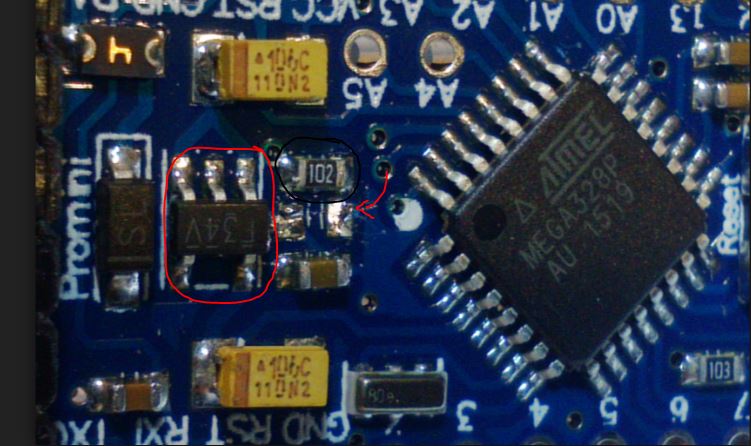
Using the internal voltage regulator (3.35 - 12v) will kill the node in weeks/days if you run them on 2-4xAA because of the high current drain. My aim building a newbie/easy PCB is a sleepcurrent of 0,1mA or 100uA.
-
hi there,
Thanks for the easypcb! I'm trying to build a small solar powered weather station (like these: https://forum.mysensors.org/topic/841/solar-powered-mini-weather-station), but just found that the battery that came with the solar panel only provides 1.2v. The booster works ok and I can power the arduino, but it's no enough for the radio :-(. Since powering the radio from the booster is not a option, I'm at a dead end. Or there's a way to still using this battery/solar panel?
-
@chrlyra - you need 1.9V minimum for the radio. There are more advanced boosters you could try which probably is better and less noice... but this PCB was not designed for that purpose so sorry, I cant help you.
-
@chrlyra
There is another project called solar harvester that uses a supercap to store energy
-
So a question I have always wondered about the voltage regulator is do you really need to desolder it if you connect your incoming power to the 3.3v pin and not the RAW pin? I would have thought the regulator would only drain power if it was converting the RAW power down to 3.3v.
-
@dbemowsk - your logic sounds right, but i think it will draw power anyway... only way to figure out is to measure or google

-
I managed to change my PCB order, I saw that one of the updates to rev9 was the ability to use Pin 2 as GPIO instead of going to the Radio where it is unused. So now I have a order for Rev9 instead.
I will try to desolder the led or resistor and the voltageregulator.
Thanks for sharing your design.
-
@popunonkok Good luck - let me know if there is any other questions.
-
@dbemowsk in fact current is leaking through the regulator when its input is floating, you can check the "reverse leakage current" value on the data sheet of the linear regulator used on your promini boards then decide if you can accept it or not, depending on your circuit.
-
Hi -
I wanted to know if this config is OK:
Attach a LIPO battery to PWR and GND.
Cut off the right side of the board.
Use a 3.3V pro mini.
Add a regulator (like a MCP1700) and necessary caps. (Spec says 1uF).The idea is that the board and sensors get 3.2V - 4.1 V (which should be OK).
The radio gets 3.3V.Thanks!
-
@ileneken3 - sounds right, you should short the jumper REG which will feed everything the LIPO voltage. If this is higher than 3.3v I dont know what will happen but adding the voltage regulator for the radio will make sure that one is ok. I dont know about the pro mini, it it can handle up to 4.1v but I guess you will find out.
-
I'm curious too if will handle the 4 volts or not

-
No problem with the promini. Limit is from atmega and it's 5.5V I think (at least 5V anyway
 )
)
You will just have HIGH level voltage at battery voltage at the outputs instead of 3.3V
-
So technically you can power a 3.3V pro mini with a LiPo battery, you only need a regulator for radio, correct? Can you still make reliable battery voltage measurement? I Have a NRF24 adapter with a AMS1117 onboard, will that still work or does it need 5v?
-
@gohan said in
 Easy/Newbie PCB for MySensors:
Easy/Newbie PCB for MySensors:So technically you can power a 3.3V pro mini with a LiPo battery, you only need a regulator for radio, correct?
Correct.
Can you still make reliable battery voltage measurement?
I Have a NRF24 adapter with a AMS1117 onboard, will that still work or does it need 5v?
From the datasheet typical dropout voltage is 1.1V and it can be up to 1.3V.
So to get 3.3V at the output you need at least 3.3 + 1.1 = 4.4V. It won't work with your battery, you need to use another voltage regulator with a much lower dropout voltage.
-
At least according to the specs, mcp1700 will do the trick (both in terms of drop out voltage and low power consumption for battery usage). I will try it.
-
I have seen these boost/buck converters https://www.aliexpress.com/store/product/5pcs-mini-1-8V-3V-3-7V-5V-to-3-3V-Boost-Buck-Low-Noise-Regulated/1525466_32365767349.html
Would they make any sense to use with LiPo batteries or other solar power source to power a node? Or would they waste too much energy?
-
Regarding the MCP1700 as a regulator (I ordered these: https://www.aliexpress.com/item/5-pcs-MCP1700-3302E-TO-MCP1700-Fixed-LDO-Voltage-Regulator/32781100568.html)
first connected the LIPO->TP4056->MCP1700 to the GND and PWR of the board. (I made a homemade little regulator board). From all appearances, it works great, and I end up with a nice compact sensor/battery. But I want to make use of the Easy/Newbie board. I tried hooking it up to the 3 pins marked regulator, but it didn't seem to do anything. Am I missing something? The orientation can be confusing, but I think I got it right. I measured 4.1 volts to the radio, which will fry it.
Thanks!
-
@ileneken3 - the board is created for Le33a voltage regulator which has a different pinout than yours.
You have to adjust to that and not just put it in according to the pcb.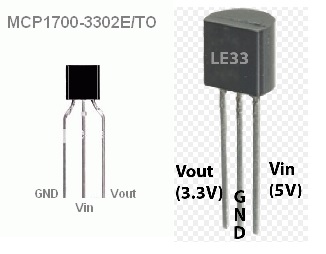
-
@sundberg84
I did adjust to the different pinout. I checked it multiple times, checked soldering - it always seems like the regulator is not regulating anything - the radio always gets 4.1 volts from the LIPO.
From looking at the specs, the LE33 is pretty close - with the biggest difference that the MCP1700 can handle more current.
Maybe I should just get the LE33 ones.Oh well...
-
@ileneken3 your problem with le33 will be the quiescent current which is high, datasheet says "typ. 50 μA in OFF
mode, 0.5 mA in ON mode, no load". 0.5mA will not give you a good battery life...
Compared to a typical value of 1.6µA on the MCP1700 (max at 4µA), you should stick to it if you are using a battery.Did you test the MCP1700 on a breadboard ?
-
@ileneken3 Can you post a pic showing how you have this wired? preferably the side where your battery is connected. I would like to see where you have your battery connected and how you have the board wired.
-
Yes, I agree. I didn't look closely enough at the currents for le33. The general rule of thumb seems to be:
Current in "milli"amps -> only days or weeks for a battery
Current in "micro"amps -> months on a batterySo MCP1700 seems to be right for a LIPO here.
I did test it on a breadboard. And then I built a little regulator board. It works great.. and I used a battery from an old cell phone that stills seems to work well.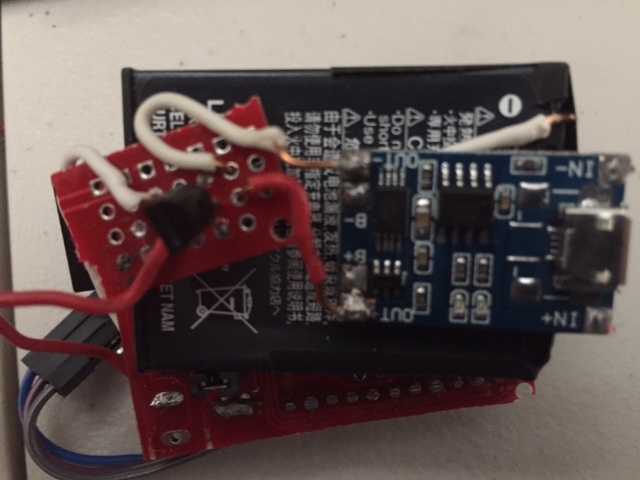
-
There's not much to the wiring (maybe that's my problem?).
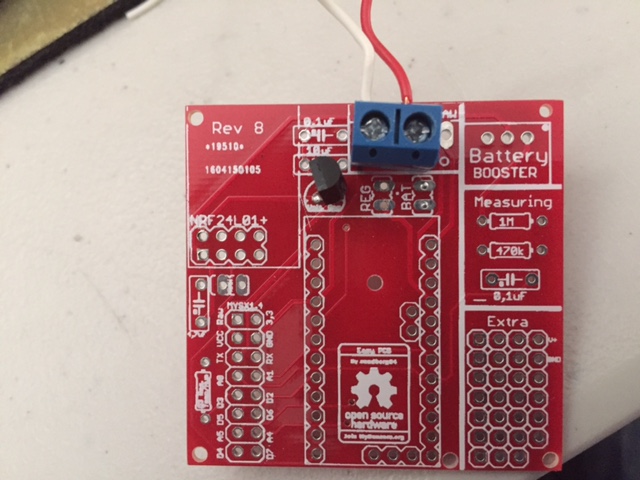
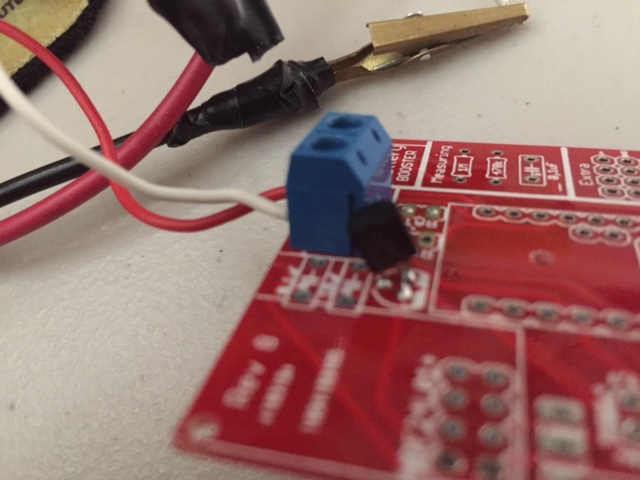
To attach the legs to be like a LE33, I swung the Vout of the MCP1700 all the way to the left.
With a multimeter, I see 4.1 volts at the radio, and everywhere else.
Thanks!
-
@ileneken3 OK, I think I see the issue. I think you need a jumper across the reg pads just to the right of the regulator. If you check with a volt meter between the regulator's V-In and the bottom reg pad, you should get continuity. Then if you check from the top reg pad to the positive lead of your battery, you should get continuity there also. you need to bridge that gap to get the power from your battery to the regulator.
You would also be wise to add the 0.1uf ceramic and 10uf electrolytic capacitors just above the regulator. The 0.1uf will filter the power coming in to the regulator, and the 10uf will filter the output of the regulator. The other capacitor not to forget is the 4.7uf electrolytic just below the nRF24 radio. If you forget that, you will surely have radio problems.
-
@ileneken3 like @dbemowsk says you need capacitors (and probably a jumper) . The LDO will go into oscillation without capacitors.
-
@ileneken3 - as mentioned the PCB is made generic so to activate the voltage regulation part (Power -> Volt Reg -> Radio) you need to add a jumper for REG. If one want to bypass the voltage regulation part you jump BAT (and use the booster instead). Have a look at the instructions here and let me know if you think something is missing. The capacitors for the voltage regulator are also recommended as mentioned.
In your case with 4.2 volts, BAT will give you 4.2 volts on the radio and nothing more (if you dont jump the booster as well) and REG will give you 4.2 volts to the arduino and sensors and the regulated voltage to the radio.
It looks like you used BAT in the pictures? If you didnt solder any BAT/REG you should not get anything. Dont solder both!
-
OK, looks like I had multiple problems.
I somehow missed the instructions about "don't solder both", and was also slightly confused about the directions because I am using a battery (LIPO), but following the "5V regulated" instructions. When the instructions mention battery, it always mean a 3.3V battery. I had the BAT jumpered, and then I tried with and without the REG jumpered.
At the same time, I believe I damaged the MCP1700 regulator - I will have to take it off and test it.
So in the interest of getting this resolved quickly, I started all over again with a new board, new regulator, and jumping only REG. It worked! Here is the picture: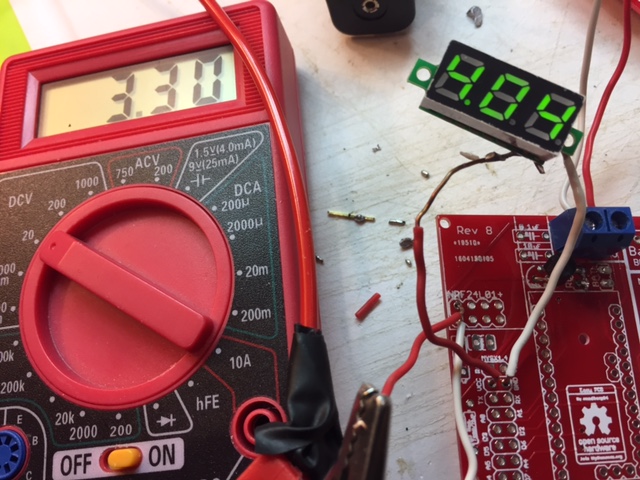
You can see that the radio will get 3.3V, and the rest of the board will get 4+ volts. (The TP4056 will cut it off as it goes down to around 3V).
So I will continue the build, and if everything goes according to spec, the radio, arduino, and sensors should all be OK. (Assuming the sensor can handle 4+ volts).
As far as the capacitors, it looks like the spec says 1uF on input and output. So I will put those where there are labels for .1 and 10uF. For the radio, I am well aware of its capacitor needs (learning the hard way). At this point, I always put the 4.7uF cap directly on the radio.
If everything goes well, I would recommend putting some sort of reference to LIPO batteries in the instructions. I couldn't be the only one who wants to do this.
Great support from everyone!
-
I am also looking at using lipo batteries, but I've been told they have a tendency to self discharge over time, so normal AA batteries or cr123 provide longer battery life of course if the node is not power hungry
-
@gohan - I can't and wont throw figures around here concerning how much they discharge per day, but they do indeed self-discharge and in my opinion wouldn't be suitable for a sleeping node.
-
@Samuel235
The key question here (at least for this forum subject), is "should you a LIPO with a Easy/Newbie PCB board"? My answer is "in some cases". For sure, the gold standard of sleeping nodes is 2 AA batteries that last over a year. It's best both in terms of price and longevity. But there are scenarios for using LIPO's:-
The AA batteries are too big. LIPO's come in all sizes, and the one from my old cell phone was nice and compact for a particular enclosure I wanted to use.
-
You have LIPO's lying around (like from an old laptop) and you just want to use them.
-
The sensors you are using are "power hungry" and you just can't find a way around it (and you can't plug it into the wall). Using a LIPO will avoid having to throw away a lot of AA's.
As far as discharge rate, from what I read it's not too bad (just not as good as AA's). With sensors that are not power hungry, and with the right voltage regulator (like a MCP1700), I am anticipating it lasting for months. At that point, it's not that big of a deal to recharge with that frequency.
For use with power hungry sensors (which may mean using just 2 ma), I am hoping for weeks.
I will continue with the experiment unless someone says I am way off in my estimations.
-
-
As requested a few images of the version 9 board, mounted for battery with some extra pin sockets while experimenting.
-
@jens-persson - Tnx, but hmmm.. I cant see them. Just a stop sign. Maybe my web-browser?
-
@sundberg84 same here
-

Thought the settings on the album should apply to the images also.
Here is a link to the album: https://goo.gl/photos/bX9HZSXdbMCvuyAv9
Does it work?
-
@jens-persson - It does! Nice images! Well done

I like you have added headers so you can add and remove quickly,.
-
is it me or that pro mini looks a little different than what I usually see?
-
@gohan It's not just you. I had some 5v pro minis that were from china that looked different than the standard ones. The outer pin config was the same, but the guts of the board weere a bit different. A4 and A5 were towards the back of the board.
-
These were bought here: https://www.aliexpress.com/item/10pcs-pro-mini-atmega168-Pro-Mini-168-Mini-ATMEGA168-3-3V-8MHz-for-Arduino/32413050538.html
-
@jens-persson they are atmega 168, that's why

-
Any comments on delivery times from itead, pcbway or seeed? Which one is fastest/easiest to deal with (I'm located in Sweden)?
-
@maghac - tried itead and pcbway and they use same shipping so shipping times has been pretty much the same.
I have some old revisions I can sell you cheap in Sweden if you need fast delivery. Rev 6 and 7 I think.
-
@sundberg84 Would be great, I'll send you a PM!
-
Got a couple of 5V DC running as "test boards". Very convenient and quick to get started. A+
Will have a few battery nodes running soon as the step ups come in.
-
@johmei - thank you for your feedback!

-
Agree, very easy to start using. Upgraded one of my old "cable spaghetti" temperature sensor nodes to this board, looks much neater now, and actually fits a lot better in the box too.
I soldered the arduino and the radio directly on the board, but then I realized that maybe it would be better to use female headers so I can replace them if I wanted. How are people generally using the boards?
-
@maghac - I do both and it depends on cases and where i put it.
Sometimes there just isnt enough room for headers but I try to make it as modular as possible... most important is the radio for me so I can easy swap and test if something goes wrong.I have a couple of test nodes (running time sketch for example) which is ONLY modular where I try out my hardware before soldering them as well.
-
@sundberg84 Makes sense. I spent a few hours troubleshooting my node and the problem turned out to be the DS18B20 sensor (actually, I had 3 bad ones, so I guess I had a bad batch), having a test board would have saved me some headache

I'm using the 100x65x35 mm plastic boxes linked in the store, I'll check if there is enough room for headers too.
-
I made one with headers everywhere, I use it to test the parts (pro mini, radio, sensors), upload the sketch etc.
Then when everything looks fine I solder the components on a new board to save space.I had a case once with a pro mini that had a pin from the atmega chip not connected to the pro mini header hole (faulty or broken track I suppose), and realized it only after the pro mini was soldered to the PCB. Now I'm more careful

-
@Nca78 - I had the exact same experience with a analog pin broken on the atmega chip. I tried to desolder it but it was broken inside the chip i think.
-
I used pcbway, was very fast with no taxes or fees via EMS unlike DHL. 3 Days from shipping notice to my door with additional 3 days to have the boards made. I had 3 different board designs made. 30 of this one, and 50 of jModules 1 & 2 EACH (oops). I submitted jModule 1 & 2 together as part of one order, with both boards in 2 zips inside 1 main zip and specified there were 2 boards and they combined them and then cut each individually resulting in 100pcs which is a ton as I expected 25 and 25. I only specified the dimensions of each board in the notes and said there were 2 sizes and 2 designs. Cost was:
$25 for 30pcs of this board specs: "48.66mm * 49.86mm ,Thickness:1.6 mm, 2 Layers, Finished Copper:1 oz Cu"
and only $ 30.00 & 50 pieces (actually 100pcs once cut) specs: "34mm * 23.1mm ,Thickness:1.6 mm, 2 Layers, Finished Copper:1 oz Cu" <-- Width is doubled with both together (oviously)If only I submitted all 3 together.
Only newbie problem was that tNames & tValues weren't printed as part of the silkscreen so I'm missing a bunch of the text including values, mysx pin layout, a bunch of stuff. tPlace was silkscreened just fine, but that is the only layer as far as silkscreening. Not the end of the world but have to either recall or look things up that weren't printed. I'll just have to make a reference card and laminate it. Problem was my fault as their suggested CAM (sfe-gerb274x), which I used after there was no drill file, doesn't include the missing layers in the Top Silkscreen GTO (just checked). I know for next time to double check the selected layers for silkscreen (and others to be safe). Live, learn and now move on to attempting my own design after learning what I want and need from the boards. Likely a middle ground between size of jModule and ease of this board with different daughterboards using MysX or custom connector.
Thanks for this great starting point! I'll be sure to donate, couldn't use openhardware as no way to combine boards or orders.
-
So it is cheaper to combine different boards and have them cut into single boards instead of ordering them on separate orders?
-
@gohan very much so. I didn't see a price difference between having 1 or 2 boards made with the jModules anyways because they are so small. It always is cheaper to panelize your boards which, in the case of pcbway, they will do for you. I didn't even select the panelize option. I left it on single and selected 2 designs as the option and it didn't increase cost likely due to small size. 100mm x 100mm is $5/10 boards so cram whatever you can into that size and your good. I likely could have got way more boards had I thought that through as 2 boards together was 34mm x 23.1mm. I'm not 100% sure the best route but I might have got more had I selected the panelize by pcbway option. There are going to be some sort of fees when you want to cram 5 different designs on one board.
Again, not 100% sure how it works as it will charge more if you request 50pcs over 20pcs but if you can fit more boards in that 100x100 space, it counts as 1 peice even if you end up with 6 as you're paying for a 100x100 board at $5/10pcs. Next time I'd put all the boards into one set of gerbers and lay it out myself to maximize # of boards possible. Actually, before I do that, I'd actually ask if that's what their panelization service would do anyways so am I wasting my time doing it myself, to which they would likely laugh and say, "yes, you pcb ordering newbie", but at least I'd have more boards.
I got a ton of stuff to mock up now to order all crammed together.
-edit-
excuse the poor english, phone is being a pain and some advertisement took me away from posting so I had to do it again and no time to proof read right now.
-
Do you use kikad to put together the different pcbs?
-
@nitroburn - thank you for input! I hope it works out for you even without values and names. Good advice with combining the boards for better price. I did so with EasyPCB + the new Easy RFM69 PCB and a secret one. I think i paid 20$ + shipping for 30 boards. (50x50, 50x50 and 25x50). I just submitted zip files and PCBWAY combined them for me.
-
@nitroburn I always panelize by hand, because most PCB companies accept it like that. They will ask you to pay if you ask for vcut (v shaped cut between board so you can split by hand), but if you cut yourself then DirtyPCB, Seeed, PCBWay,... don't care. And if you make thickness <1mm it's very easy to cut with basic scissors.
Seeed is also 5$ for 10 100*100mm boards now, and they have no stuff like "paypal fee" and much cheaper shipment costs, at least for me.
-
@Nca78 - ah so thats why it was so cheap, they have gone from 10$ to 5$ for 10pcs 10x10. PCBWay as well I see now.
-
@sundberg84: sadly I only did it for the jModule boards but realize now I should have done it with your board as well since I could have got 4x as many for the same price. I realized after I could have got significantly more of those as well, or just have spent less. Might have had to trim a little bit from the dimensions though as I don't know about clearances using the full 100x100 without room to split the boards, but I could be wrong due to them being square Actually, after just checking pcbway's site it says, "Leave min clearance of 1.6mm between boards for break-routing. For V-score panelization, set the space between boards to be zero." so I could have got 120 boards for $25 as they are actually 48.66x49.86 per board. Or combined different boards together as I think 120 would be overkill
 I never realized how inexpensive it is compared to etching your own. It would be crazy to etch at these prices.
I never realized how inexpensive it is compared to etching your own. It would be crazy to etch at these prices.Thanks for the great starting point and learning experience.
@Nca78: Yeah, PCBways base price is $5 for 10 100x100 as well but they don't seem to charge for vcut (doesn't change quote) and allow 0mm spacing so no need to cut. I used EMS to ship and was here in 3 days without taxes or fees unlike DHL has every single time I use them. $15 just to collect $0.10 in tax.
-
I never received so fast with EMS.
And I'm always dubious about the ultra positive comments on PCBWay as you never know (in fact, you know it
 ) if it's a way to get a discount for the next order via their marketing program....
) if it's a way to get a discount for the next order via their marketing program....I never did it because my experience with them is mixed, they have a fancy website with all process details but the PCB they sent me had really subpar silkscreen, way lower quality than any other PCB makers. And on one of my boards (not EasyPCB which was ok) I had problem with quality with a long track that peeled away when I unsoldered a component to replace it. Never had that on boards from DirtyPCB or Seeed.
-
@Nca78 and I've had a bunch of problems with seeed, however that wasn't related to their pcb services just their store and various bugs with the site that I had to multiple times point out to them and months later still needed to be fixed. (ie, incorrect paypal checkout flow that processes orders without a chance for final review as it should, and says will happen. Other people's PCB orders filling my cart with their gerbers and all. selling a galileo gen2 board right beside a gen1 case with no mention of incompatibility or that the case was for gen1 and at the time only the gen2 and that one case was for sale and they didn't seem to care that it was confusing, plus many other issues across just a couple orders. Seemed to be horrible customer service there.)
-
Everytime I panelize anything I get charged for specifying that it is panelized, even if i specify that i've done it and don't need them to do such. Do you just submit the board as a normal board but have your milling and drills such that it allows you to remove them all when you receive the product?
-
@Samuel235 you should not specify that you have panelized your boards.
And yes I use milling for complex shapes so I just have a few straight lines to cut with scissors. I did it with DirtyPCB last time and had no problem.
Seeed explains you should just not select panelizing related options when you order and they will not care.
-
@jens-persson What's the 0.1 uF capacitor next to the battery terminals for?
-
@maghac - below the booster on the right side? it is an output capacitor to filter the output on the booster. There isnt any evidence this works and there are capacitors on the booster itself as well, but I found that a 0.1uF capacitor worked great on one of my nodes which was all ST=FAIL (radio transmit/ack fail) until i added this. I have found that a cheramic capacitors on the booster worked best for some reason.
-
@sundberg84 Aha, good to know. Can't hurt to add it I suppose.
But I was actually wondering about the other one - to the left and above where the 5V->3.3V regulator would sit.
-
@maghac - this one?
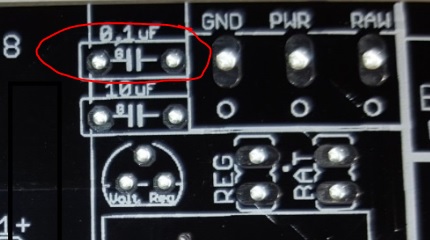
Its to maintain stability of the voltage regulator. If you look at different datasheet most voltage regulators has a typical application schematics where different capacitors is added before and after to make this. So the 10 and 0,1uF work together. Why 0,1 and 10? Well - I have seen this setup on the forum many times so I just went with that. There is alof to read about this, but I think the smaller cap can react faster while the bigger cap have more juice to give so to say.
-
@sundberg84 Ok, I see. I do have those caps on my (so far) only 5V mysensor node, somewhere I read that you need them but I wasn't sure why - thanks for the explanation.
But I suppose there is no reason to add them unless you are actually using the voltage regulator to power the radio? I noticed that @jens-persson added the smaller cap on the pics he posted earlier, but those nodes were battery powered.
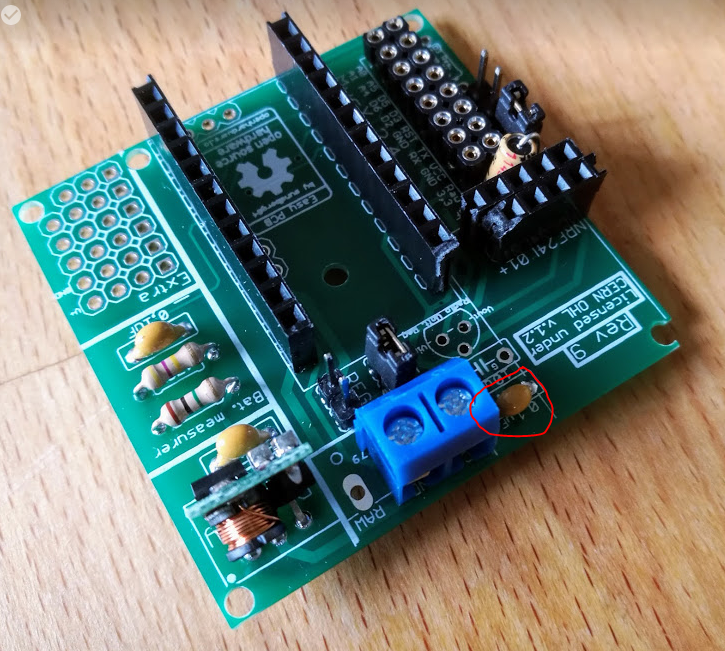
-
@maghac - not really, I have not used them with batteries.
In that setup the 0,1cap is in paralell with the 4,7uF cap for the radio. Sure, might give some more stability to the radio itself but the 4,7uF cap should be enought. If you experience alof of errors you can try adding different values here to give more stability - but in normal operations it should not be needed.Edit - sorry not 0,1uF, but 10uF cap is in parallell. The 0,1uF does nothing if you dont have a voltage regulator.
Edit 2 (note to myself) - Maybe I should change the 0,1 and 10uF for next rev so 10 is on the input and 0,1uf on th output instead.
-
@sundberg84 Ok, it doesn't hurt since capacitors in parallel are simply just added (if I remember my electronics classes correctly).
So the end result is that you have a 14.7 uF cap on the radio.
-
@maghac it is not just as simple as the capacitor size is added, true it is added but different size capacitors also filter disturbances at different frequencies. So adding different size capacitors in parallel can act as a more effective disturbance filter.
-
@korttoma @maghac - Exactly how they work is beyond my knowledge... im more of a trial and error guy (hence the 9th revision
 ) but korttoma has right, and from experience I would go with a lower and a higher capacitor to try first, ie 0,1 and 10. 4,7 + 10 is to me two higher value capacitor.
) but korttoma has right, and from experience I would go with a lower and a higher capacitor to try first, ie 0,1 and 10. 4,7 + 10 is to me two higher value capacitor.
-
A capacitor is considered a short to an AC signal and it works on certain frequencies depending on the setup. So if you get any AC ripple on your output of your regulator, the capacitor is used to smooth that out. Electrolytics are also use to give a quick extra burst of power when needed. That is why they are used for things like the incoming power for the radio. The radio transmits every so often and if you were to look at the power coming in to the radio on a scope with no capacitor on it, you would probably see dips in the power when it transmits. The dips in power could cause it to fall outside the operating range of the radio for a split second giving you transmission loss. The electrolytic is there to supply that extra jolt to stabilize the power on the transmit cycles.
And @maghac, you are correct, parallel capacitance adds and series capacitance divides, which is the opposite of resistors where series resistance adds and parallel resistance divides.
-
@nitroburn said in
 Easy/Newbie PCB for MySensors:
Easy/Newbie PCB for MySensors:@Nca78: Yeah, PCBways base price is $5 for 10 100x100 as well but they don't seem to charge for vcut (doesn't change quote) and allow 0mm spacing so no need to cut. I used EMS to ship and was here in 3 days without taxes or fees unlike DHL has every single time I use them. $15 just to collect $0.10 in tax.
So yesterday I tried to submit my PCBs to PCBWay, they accept similar design if you don't check panelizing options, but my interest is to lower prices by combining different PCBs on the same board. I don't need them to cut anything, but they just refused and changed to panelized version. In the end it was 137$ compared to less than 70 with Seeed.
So PCBWay is great to have many similar boards (but who really needs 50-60 items of the same board ?) but if you want to save costs by combining multiple boards it's not an option.
-
@Nca78 - This is exactly why i was shocked when someone got away with it. They get personally checked every time and soon as they pick something up where they can see two separate boards there then they refuse it unless you paid the extra for the panelising.
-
Draw some fake routes across the boards, maybe they will not notice it

-
@Nca78 said in
 Easy/Newbie PCB for MySensors:
Easy/Newbie PCB for MySensors:So yesterday I tried to submit my PCBs to PCBWay, they accept similar design if you don't check panelizing options, but my interest is to lower prices by combining different PCBs on the same board. I don't need them to cut anything, but they just refused and changed to panelized version. In the end it was 137$ compared to less than 70 with Seeed.
So PCBWay is great to have many similar boards (but who really needs 50-60 items of the same board ?) but if you want to save costs by combining multiple boards it's not an option.I combined different PCBs and right on the form for submitting them for a quote it explains you just select how many different designs you want per board, so if you fit 3 different designs but with 8 total boards from the 100x100, you just enter 3 designs and submit all 3 gerbers individually zipped inside a main zip file. In my case, I selected 2 designs and submitted both as single not panalized. You can always just copypaste them together in eagle or something and avoid them saying anything about it.
Only extra thing I did was submit the board size as the 2 designs added together then in the requirements specified there were 2 designs one being X * Y and the other X * Y. I don't know if they would have accepted me requesting they then put the designs onto one board more then once, but I assume that is what they would do for the panalization. It definitely doesn't have to be the same design on 1 board. Order 10 pcs, fit 4 designs or 2 designs 2 time and end up with 40 total PCBs. But I do notice if you have 2 designs done 8 times total and you want the boards pre-separated then you would say 8. But yeah, that does raise the price. Weird because I swear it wasn't doing it like that before.
I guess I just got lucky and had a nice person review my files and they combined and separated them for me for free. In the future I'm just going to throw a panel together myself and submit as 1 design and maybe not even bother to have them score the boards, I'll do it myself and then it's definitely 1 design. They must have felt bad I was ordering 30x23 boards wasting the rest of the 100x100 so they threw them together. Its a 10 second copy and paste so I'll just do it myself next time and not bother with them charging more. Could also be they counted it as 1 design because the sizes were nearly identical.
-
A completely unrelated question: what is that header called that @jens-persson used on the MySX connector (see the pic that I reposted above)? I soldered the longer, jumper-style, headers instead so I can connect dupont wires.
Are there any benefits to using this other type of header? (And what does the corresponding male connector look like)?
-
@maghac said in
 Easy/Newbie PCB for MySensors:
Easy/Newbie PCB for MySensors:A completely unrelated question: what is that header called that @jens-persson used on the MySX connector (see the pic that I reposted above)? I soldered the longer, jumper-style, headers instead so I can connect dupont wires.
Are there any benefits to using this other type of header? (And what does the corresponding male connector look like)?
It's just header with round pins. No interest in using them IMHO, better stick to the standard square shaped headers as they are the more common. You cannot use standard square shaped headers with those so it's a bit limiting.
-
Please note, that when using the link to ITEAD, the order is not actually completed. The order is received by ITEAD, you get an order confirmation and everything, but the order is actually not processing before you upload the gerber files.
This may be a beginners mistake, as it is the first time i'm using this service. I had the understanding that when you pressed the shopping cart above, and chose a service the gerber-part of the transaction would be handled automatic.
I dont know if this is a misunderstanding on my side, I may have misunderstood the instructions on this site. It also may be an error on ITEAD's side as they didn't process the order correctly.
What is your experience with this ?
My problem is solved now, as I wrote and asked ITEAD for status. They made me aware of the issue and I emailed them the gerbers.This is in no way a critique of the project. I really appreciate the hours of work put into it.
-
@R2DK, sounds strange.
Should just be a one-click operation to order... and you shouldn't have to do any gerber uploads.
Could you PM me who you were in contact with over at ITEAD?
-
We have sold pcbs from itead before and this is the first time I hear this. As @hek said it should be a 1 click operation but something maybe went wrong just this time?
-
This happened to me too, I ordered from the link, and thought I was Ok with the order. Yesterday I did find out that my order was waiting for the gerber files, so I downloaded, zipped and uploaded the to itead. I also mailed them about it. Got a reply that they should check the gerber files.